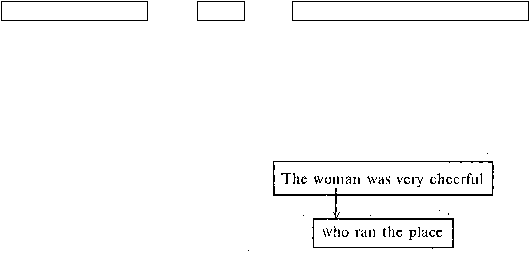
338
(c) What surprised him was that there was no pain about it.
It is a complex sentence with a subject and a predicative clause. The subject clause is introduced by the
conjunctive pronoun what and the predicative clause by the conjunction that. Since these clauses occupy the
positions of the main parts of the sentence, the main (principal) clause is reduced to the link verb only.
What surprised him
<
was
>
that there was no pain about it
2. (a) The woman who ran the place was very cheerful.
It is a complex sentence comprising (or consisting of) two clauses. The main clause is The woman was very
cheerful. The subordinate clause is who ran the place. It is a restrictive (limiting) relative attributive clause
modifying the subject of the main clause as its antecedent.
The same graphical presentation is to be found in other complex sentences containing one subordinate
clause.
(b) The next book she wrote she sent to a magazine.
It is a complex sentence with a contact clause dependent on the antecedent the next book, which is the
subject of the main clause.
Or:
It is a complex sentence containing a restrictive attributive clause joined to the main clause asyndetically.
(c) Stratford-on-Avon, -where Shakespeare was born, is visited by thousands of tourists.
It is a complex sentence with a descriptive (or non-restrictive) attributive clause introduced by the relative
adverb where, which refers to the antecedent Stratford-on-Avon in the main clause.
(d) Look before you leap.
It is a complex sentence with an adverbial clause of time introduced by the conjunction before and
depending on-the predicate of the main clause.
(e) Bad as things are, we mustn’t give up hope.
It is a complex sentence with an adverbial clause of concession. The concessive clause is introduced by the
conjunction as with inverted word order in the subordinate clause. It modifies the whole of the main clause.
3. I
did not tell Muriel on my return to London what George had said to me, or what he looked like, but
contended myself with assuring her that he was well and happy.
It is a complex sentence comprising one main clause and three subordinate object clauses. The main clause
contains two homogeneous predicates (did not tell and contended) connected by the conjunction but. The first
and the second subordinate clauses are homogeneous, they are joined to each other by the disjunctive
conjunction or and introduced by the conjunctive pronoun what. Both modify the first of the two homogeneous
predicates. The third object clause is introduced by the conjunction that. It depends on the object to the second
homogeneous predicate with assuring.

